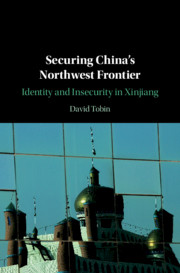Book contents
- Securing China’s Northwest Frontier
- Securing China’s Northwest Frontier
- Copyright page
- Dedication
- Contents
- Figures
- Abbreviations
- Introduction
- 1 Securing China on the Multi-Ethnic Frontier
- 2 Mass Education as an Identity-Security Practice
- 3 ‘East Turkestan’ in China’s Identity and Security Narratives
- 4 Identity and Insecurity after ‘7-5’
- 5 Performing Inclusion of the Uyghur Other
- 6 Han and Uyghur Narratives on Ethnic and National Identity
- 7 Han and Uyghur Narratives on Identity and Insecurity
- Conclusion
- Book part
- Bibliography
- Index
3 - ‘East Turkestan’ in China’s Identity and Security Narratives
Published online by Cambridge University Press: 18 September 2020
- Securing China’s Northwest Frontier
- Securing China’s Northwest Frontier
- Copyright page
- Dedication
- Contents
- Figures
- Abbreviations
- Introduction
- 1 Securing China on the Multi-Ethnic Frontier
- 2 Mass Education as an Identity-Security Practice
- 3 ‘East Turkestan’ in China’s Identity and Security Narratives
- 4 Identity and Insecurity after ‘7-5’
- 5 Performing Inclusion of the Uyghur Other
- 6 Han and Uyghur Narratives on Ethnic and National Identity
- 7 Han and Uyghur Narratives on Identity and Insecurity
- Conclusion
- Book part
- Bibliography
- Index
Summary
Chapter 3 analyses exclusion of Uyghur identities in Zhonghua Minzu, specifically the 'East Turkestan' (dongtu 东突) narrative in minzu tuanjie education texts that explain contemporary violence and articulate Uyghur-ness as an external threat through the Turk category. The first section analyses how official East Turkestan narratives project external territorial borders and internal ethnic boundaries through each other, marking Uyghur language and religion as internal security problems from outside China’s cultural boundaries. The second section analyses official explanations of violence and protest in Xinjiang through East Turkestan and 'inside/outside Three Evils' ('terrorism, separatism, and extremism') narratives. This analyses how the party-state turns external cultural boundaries inward, demarcating ethno-spatial boundaries between sub-regions that are more and less secure and more and less Chinese. The final section uses semi-structured interviews and discourse analysis of Nurmehemmet Yasin’s short story 'Wild Pigeon' to examine the productive effects of these narratives. It analyses how Uyghurs redeploy official East Turkestan narratives to articulate alternative configurations of identity and security. The chapter argues that tensions between inclusion and exclusion in official security discourses, which ambivalently inter-weave civilisational and nationalist discourses by identifying intertwined threats inside and outside Zhonghua Minzu produce possibilities for resistance within its logics.
Keywords
- Type
- Chapter
- Information
- Securing China's Northwest FrontierIdentity and Insecurity in Xinjiang, pp. 87 - 113Publisher: Cambridge University PressPrint publication year: 2020

